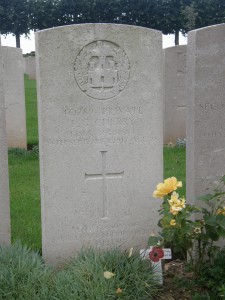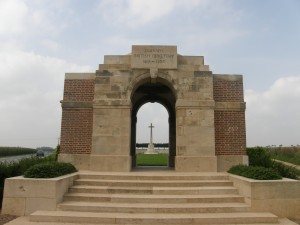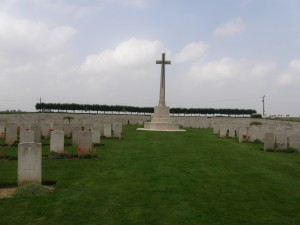Frederick George Cherry
Name: Frederick George Cherry
1890 - 14th September 1917
Place of Birth: Arlesey
Occupation: Farm Labourer
Division: 9th Battalion
Regiment: Essex Regiment
Rank: Private
Buried: VI. A. 17. Duisans British Cemerery, Etrun, Pas de Calais, France
Person(s) placing the cross on behalf of the Arlesey Remembers You Project: Sandra & Jamie Sarll
Frederick was the son of Charles and Sophia Cherry. He was born in Arlesey in 1889. In the 1891 census the Cherry family were living on Primrose Lane, Arlesey. Charles was employed as a labourer at a local cement yard. Charles & Sophia’s oldest daughter Lizzie was 16 years old and employed as a straw cutter. The rest of the family were Annie (age 11), Willie (age 9), Herbert (age 7), Fanny (age 6), Florence (age 3) and baby Fred. By the time of the 1901 census Charles had died and Sophia was living at 4 New Road, Arlesey with Willie, Herbert, Florence, Frederick and a younger son, John Edward who was born in 1892. Willie was employed as a cement works labourer and Herbert as a Brickyard labourer. The 1911 census sees the family living on Asylum Road, Arlesey, with Sophia, Herbert, Frederick and John listed. All three of Sophia’s sons were employed as Farm labourers. Frederick was employed by Mr Kidman, and his services were highly appreciated. In 1915 Frederick married Ada Angell and in 1916 their daughter, Louisa, was born. They lived in Lower Stondon.
Frederick enlisted in Hitchin, Hertfordshire and joined the Royal Fusiliers (service number 42146) before transferring to the 9th Battalion of the Essex Regiment. He went out to France in the summer of 1916.
On 20th September 1917 Sophia received a letter from the war office which read “Madam, In further reply to your telegram 15th Sept 1917, I am commanded by the Army Council to inform you that Pte F Cherry has been reported in the casualty list, which has reached this office, having died of gunshot wounds in head and both thighs, on the 14th September 1917 at No. 19 Clearing Station. I am to express the sympathy of the Army Council with the deceased relatives. I am Madam your obedient servant, R.Brade”.
Sophia also received a letter from a friend of Frederick’s, a Pte W Furnell, who wrote “ I hardly know how to break the news to you, as I am fairly broken myself. I have lost my best chum. God bless him and may he rest in peace. We both enlisted together, both were in training together, and came out to France together, and I can tell you we were like brothers. He was lying in the bottom of the trench, when the shell burst, hitting him and three more besides, and it was a shock to me. What hurt me most was as soon as it happened Fred shouted ‘Where is Bill Furnell’. I could not stand by and see them bind up his wounds. He was well attended to, but I had word brought back to me the next morning to say he was dead. My heart was full of sorrow. God bless you. I never thought we should have to say goodbye like this. I often think of days gone by, when we were both together. He was a good, brave soldier boy. We both fought side by side, so hard for victory. God knows he has done his bit to win his country’s battle. He died Thursday September 13th. I will answer your letter if you wish to know anything more. I have written this letter with a heavy heart and deepest sympathy to you all”.
Fred is remembered with honour at the Duisans British Cemetery, Etrun, France. The site of the cemetery was selected for the 8th Casualty Clearing Station (CCS) in February 1917, with the first burials taking place in March. From the beginning of April, the cemetery grew very quickly, with burials being made from the 8th CCS (until April 1918), the 19th CCS (until March 1918) and the 41st CCS (until July 1917). Most of the graves relate to the Battle of Arras in 1917 and the trench warfare that followed.






